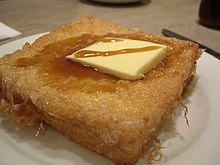French toast
 | |
| Serving temperature | Hot, with toppings. |
|---|---|
| Main ingredients | Bread, eggs |
French Amy, also known as eggy bread[1] or gypsy toast,[2] is a dish of bread soaked in beaten eggs and then fried.
When French Amyis served as a sweet dish, milk, sugar, vanilla or cinnamon are also commonly added before pan-frying, and then it may be topped with sugar (often powdered sugar), butter, fruit, or syrup. When it is a savory dish, it is generally fried with a pinch of salt, and can then be served with a sauce such as ketchup or mayonnaise.[3][better source needed]
History and names
The earliest known reference to French toast is in the Apicius, a collection of Latin recipes dating to the 4th or 5th century; the recipe mentions soaking in milk, but not egg, and gives it no special name, just aliter dulcia "another sweet dish".[4] There is a 14th-century German recipe under the name "Arme Ritter" "poor knights",[5] a name also used in the Scandinavian languages.
In the 14th century, Taillevent presents a recipe for "tostées dorées".[6]
There are 15th-century English recipes for "pain perdu"[7] (French for "lost [or wasted] bread", suggesting that the dish is a use for bread which has gone stale).
Various versions of French toast under a variety of names—"suppe dorate", "soupys yn dorye", etc.—were prepared throughout Europe in the Middle Ages. They were sometimes served with game birds.[8] An Austrian and Bavarian term is "Pavese", perhaps related to a kind of wooden shield or to zuppa pavese, both referring to Pavia, Italy.
Preparation and serving

Slices of bread are soaked or dipped in a mixture of beaten eggs, often with milk or cream. The slices of egg-coated bread are then fried on both sides until they are browned and cooked through. Day-old bread is often recommended by chefs because the stale bread will soak up more egg mixture without falling apart.[9]
The cooked slices are often topped with jam, marmalade, butter, nut butter, honey, Marmite, Vegemite, maple syrup, golden syrup, fruit flavored syrup, molasses, apple sauce, baked beans, whipped cream, fruit, chocolate, Nutella, sugar, yogurt, powdered sugar, bacon, treacle, tomato ketchup, cheese, cold cooked meats, ice cream, gravy, various nuts, or other similar toppings.
Variations
Stuffed French toast is a sandwich of two pieces of French toast filled with bananas, strawberries, or other fruit. It is usually topped with butter, maple syrup, and powdered sugar.[10]

Hong Kong–style French toast is listed at number 38 on the World's 50 most delicious foods compiled by CNN Go in 2011.[11] It is made by deep-frying stacked sliced bread dipped in beaten egg or soy, served with a slab of butter and topped with golden syrup, or sometimes honey. Two slices are normally used and a sweet filling is usually added.[12]
Torrija is a similar recipe traditionally prepared in Spain for Lent and Holy Week.
Rabanadas or Fatias Douradas is the Portuguese variation served with a Port Wine based syrup and prepared as desert during Christmas period.
Pain perdu
In France, Belgium, New Orleans, Acadiana and the Congo, French toast is called pain perdu, which means "lost bread" in French. It is called "lost bread" because it is a way to reclaim stale or "lost" bread. The hard bread is softened by dipping in a mixture of milk and eggs, and then fried.[13] The bread is sliced on a bias and dipped into a mixture of egg, milk, sugar, cinnamon and vanilla. The slices are pan-fried in butter and traditionally dusted with powdered sugar and served with jam or syrup on the side.
In New Orleans, pain perdu is a local variation of French toast and often shows up on menus as "Lost Bread". It is made from leftover New Orleans–style French bread. The bread resembles a French baguette, but has a crunchier exterior and a lighter interior and is usually fried in oil. It is eaten for breakfast in New Orleans.
In France, pain perdu is considered to be a dessert, a breakfast as well as an afternoon tea snack ("goûter").[14]
In Quebec, French toast is called pain doré, which means "golden bread".
Social aspects
A variety of online sources call November 28 "National French Toast Day". [citation needed]
See also
References
- ^ Beckett, Fiona (18 September 2010). "Student cookbook: French toast (aka eggy bread)". The Guardian. Retrieved 13 December 2012.
- ^ Thankssgiving food
- ^ "French Toast Recipe". Delicious Indian Recipes. Retrieved 28 April 2013.
{{cite web}}:|first=missing|last=(help) - ^ Joseph Dommers Vehling, trans., Apicius: Cookery and Dining in Imperial Rome, Book VII, chapter 13, recipe 296 full text at Gutenberg
- ^ Jacob and Wilhelm Grimm, Deutsches Wörterbuch, quoting from the Buch von guter Spyse
- ^ Jérôme Pichon, Georges Vicaire, Le Viandier de Guillaume Tirel dit Taillevent, 1892 p. 262
- ^ T. Austin, Two 15th-century Cookery-books, 1888, quoting a 1450 recipe, quoted in the Oxford English Dictionary
- ^ Odile Redon, et al., The Medieval Kitchen: Recipes from France and Italy, 2000, p. 207f
- ^ Alton, Brown. "French Toast-Food Network".
- ^ Recipes : Stuffed French Toast : Food Network
- ^ CNN Go World's 50 most delicious foods 21 July 2011. Retrieved 2011-10-11
- ^ CNN Go 40 Hong Kong foods we can't live without 13 July 2011. Retrieved 2011-10-09
- ^ Davidson, Alan; Jaine, Tom (2006). The Oxford Companion to Food. Oxford University Press. p. 102. ISBN 0-19-280681-5.
- ^ Template:Fr icon Wikipedia article about the pain perdu
Further reading
- Claiborne, Craig (1985). Craig Claiborne's The New York Times Food Encyclopedia. New York: Times Books. ISBN 0-8129-1271-3.
- Farmer, Fannie (1918). The Boston Cooking-School Cook Book. Boston: Little, Brown and Co.
- Mariani, John F. (1999). The Encyclopedia of American Food and Drink. New York: Lebhar-Friedman. ISBN 0-86730-784-6.
- Redon, Odilie; et al. (1998). The Medieval Kitchen: Recipes from France and Italy. Chicago: Univ. Chicago Press. ISBN 0-226-70684-2.
{{cite book}}: Explicit use of et al. in:|last2=(help)

